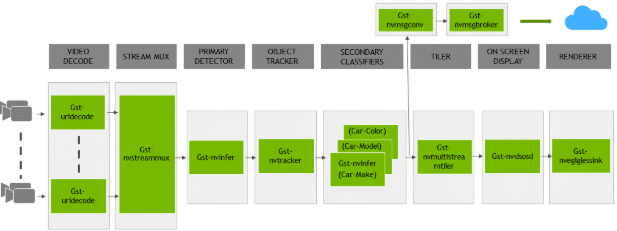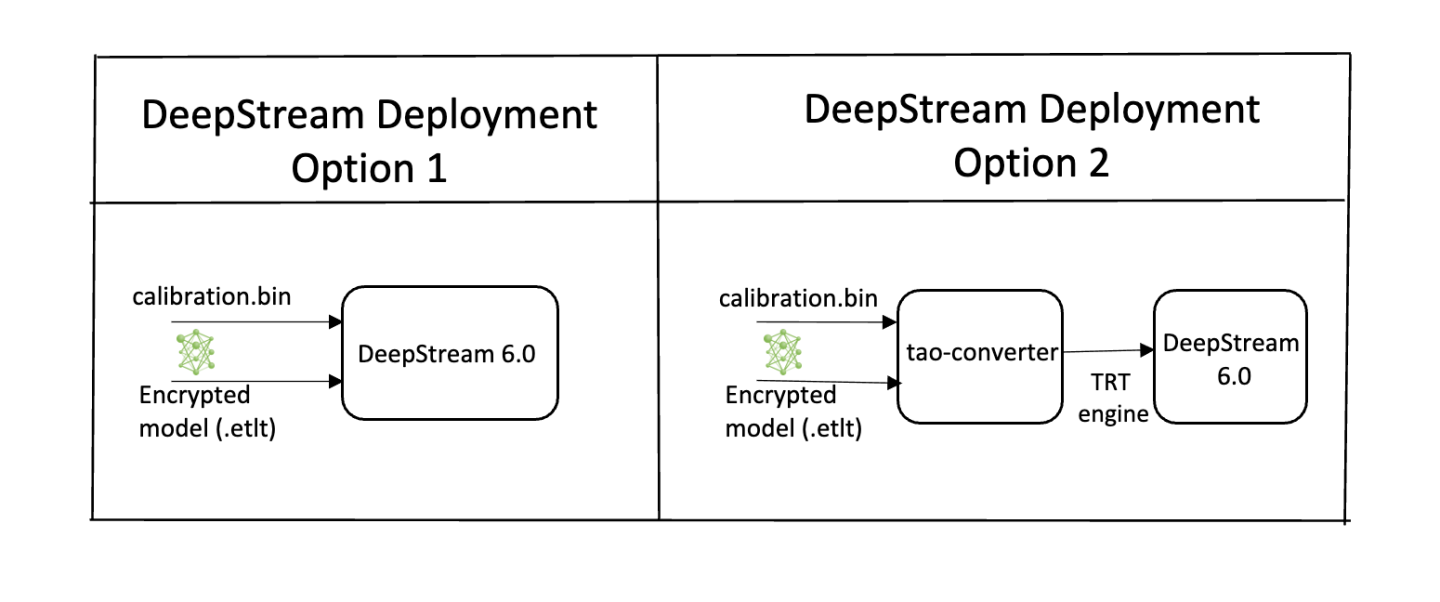Deploying to DeepStream for YOLOv4-tiny
The deep learning and computer vision models that you’ve trained can be deployed on edge devices, such as a Jetson Xavier or Jetson Nano, a discrete GPU, or in the cloud with NVIDIA GPUs. TAO Toolkit has been designed to integrate with DeepStream SDK, so models trained with TAO Toolkit will work out of the box with DeepStream SDK.
DeepStream SDK is a streaming analytic toolkit to accelerate building AI-based video analytic applications. This section will describe how to deploy your trained model to DeepStream SDK.
To deploy a model trained by TAO Toolkit to DeepStream we have two options:
Option 1: Integrate the
.etltmodel directly in the DeepStream app. The model file is generated by export.Option 2: Generate a device-specific optimized TensorRT engine using TAO Deploy. The generated TensorRT engine file can also be ingested by DeepStream.
Option 3 (Deprecated for x86 devices): Generate a device-specific optimized TensorRT engine using TAO Converter.
Machine-specific optimizations are done as part of the engine creation process, so a distinct engine should be generated for each environment and hardware configuration. If the TensorRT or CUDA libraries of the inference environment are updated (including minor version updates), or if a new model is generated, new engines need to be generated. Running an engine that was generated with a different version of TensorRT and CUDA is not supported and will cause unknown behavior that affects inference speed, accuracy, and stability, or it may fail to run altogether.
Option 1 is very straightforward. The .etlt file and calibration cache are directly
used by DeepStream. DeepStream will automatically generate the TensorRT engine file and then run
inference. TensorRT engine generation can take some time depending on size of the model
and type of hardware.
Engine generation can be done ahead of time with Option 2: TAO Deploy is used to convert the .etlt
file to TensorRT; this file is then provided directly to DeepStream. The TAO Deploy workflow is similar to
TAO Converter, which is deprecated for x86 devices in TAO version 4.0.0 but is still required for
deployment to Jetson devices.
See the Exporting the Model section for more details on how to export a TAO model.
As of 4.0.0, tao converter is deprecated. This method may not be
available in the future releases. This section is only applicable
if you’re still using tao converter for legacy. For tao-deploy,
please jump to Integrating YOLOv4-tiny Model.
The TensorRT OSS build is required for YOLOv4-tiny models. This is required because several TensorRT
plugins that are required by these models are only available in TensorRT open source repo and not
in the general TensorRT release. Specifically, for YOLOv4-tiny, we need the batchTilePlugin and
batchedNMSPlugin.
If the deployment platform is x86 with an NVIDIA GPU, follow the TensorRT OSS on x86 instructions; if your deployment is on an NVIDIA Jetson platform, follow the TensorRT OSS on Jetson (ARM64) instructions.
TensorRT OSS on x86
Building TensorRT OSS on x86:
Install Cmake (>=3.13).
NoteTensorRT OSS requires cmake >= v3.13, so install cmake 3.13 if your cmake version is lower than 3.13c
sudo apt remove --purge --auto-remove cmake wget https://github.com/Kitware/CMake/releases/download/v3.13.5/cmake-3.13.5.tar.gz tar xvf cmake-3.13.5.tar.gz cd cmake-3.13.5/ ./configure make -j$(nproc) sudo make install sudo ln -s /usr/local/bin/cmake /usr/bin/cmake
Get GPU architecture. The
GPU_ARCHSvalue can be retrieved by thedeviceQueryCUDA sample:cd /usr/local/cuda/samples/1_Utilities/deviceQuery sudo make ./deviceQuery
If the
/usr/local/cuda/samplesdoesn’t exist in your system, you could downloaddeviceQuery.cppfrom this GitHub repo. Compile and rundeviceQuery.nvcc deviceQuery.cpp -o deviceQuery ./deviceQuery
This command will output something like this, which indicates the
GPU_ARCHSis75based on CUDA Capability major/minor version.Detected 2 CUDA Capable device(s) Device 0: "Tesla T4" CUDA Driver Version / Runtime Version 10.2 / 10.2 CUDA Capability Major/Minor version number: 7.5
Build TensorRT OSS:
git clone -b 21.08 https://github.com/nvidia/TensorRT cd TensorRT/ git submodule update --init --recursive export TRT_SOURCE=`pwd` cd $TRT_SOURCE mkdir -p build && cd build
NoteMake sure your
GPU_ARCHSfrom step 2 is in TensorRT OSSCMakeLists.txt. If GPU_ARCHS is not in TensorRT OSSCMakeLists.txt, add-DGPU_ARCHS=<VER>as below, where<VER>representsGPU_ARCHSfrom step 2./usr/local/bin/cmake .. -DGPU_ARCHS=xy -DTRT_LIB_DIR=/usr/lib/x86_64-linux-gnu/ -DCMAKE_C_COMPILER=/usr/bin/gcc -DTRT_BIN_DIR=`pwd`/out make nvinfer_plugin -j$(nproc)
After building ends successfully,
libnvinfer_plugin.so*will be generated under\`pwd\`/out/.Replace the original
libnvinfer_plugin.so*:sudo mv /usr/lib/x86_64-linux-gnu/libnvinfer_plugin.so.8.x.y ${HOME}/libnvinfer_plugin.so.8.x.y.bak // backup original libnvinfer_plugin.so.x.y sudo cp $TRT_SOURCE/`pwd`/out/libnvinfer_plugin.so.8.m.n /usr/lib/x86_64-linux-gnu/libnvinfer_plugin.so.8.x.y sudo ldconfig
TensorRT OSS on Jetson (ARM64)
Install Cmake (>=3.13)
NoteTensorRT OSS requires cmake >= v3.13, while the default cmake on Jetson/Ubuntu 18.04 is cmake 3.10.2.
Upgrade TensorRT OSS using:
sudo apt remove --purge --auto-remove cmake wget https://github.com/Kitware/CMake/releases/download/v3.13.5/cmake-3.13.5.tar.gz tar xvf cmake-3.13.5.tar.gz cd cmake-3.13.5/ ./configure make -j$(nproc) sudo make install sudo ln -s /usr/local/bin/cmake /usr/bin/cmake
Get GPU architecture based on your platform. The
GPU_ARCHSfor different Jetson platform are given in the following table.Jetson Platform
GPU_ARCHS
Nano/Tx1
53
Tx2
62
AGX Xavier/Xavier NX
72
Build TensorRT OSS:
git clone -b 21.03 https://github.com/nvidia/TensorRT cd TensorRT/ git submodule update --init --recursive export TRT_SOURCE=`pwd` cd $TRT_SOURCE mkdir -p build && cd build
NoteThe
-DGPU_ARCHS=72below is for Xavier or NX, for other Jetson platform, change72referring toGPU_ARCHSfrom step 2./usr/local/bin/cmake .. -DGPU_ARCHS=72 -DTRT_LIB_DIR=/usr/lib/aarch64-linux-gnu/ -DCMAKE_C_COMPILER=/usr/bin/gcc -DTRT_BIN_DIR=`pwd`/out make nvinfer_plugin -j$(nproc)
After building ends successfully,
libnvinfer_plugin.so*will be generated under‘pwd’/out/.Replace
"libnvinfer_plugin.so*"with the newly generated.sudo mv /usr/lib/aarch64-linux-gnu/libnvinfer_plugin.so.8.x.y ${HOME}/libnvinfer_plugin.so.8.x.y.bak // backup original libnvinfer_plugin.so.x.y sudo cp `pwd`/out/libnvinfer_plugin.so.8.m.n /usr/lib/aarch64-linux-gnu/libnvinfer_plugin.so.8.x.y sudo ldconfig
To integrate a model trained by TAO Toolkit with DeepStream, you should generate a device-specific optimized TensorRT engine using TAO Deploy.. The generated TensorRT engine file can then be ingested by DeepStream. DeepStream can also generate TensorRT engine on-the-fly for YOLOv4-tiny if only etlt models are provided.
For YOLOv4-tiny, you will need to build the TensorRT open-source plugins and custom bounding-box parser. The instructions to build TensorRT open-source plugins are provided in the TensorRT Open Source Software (OSS) section above. The instructions to build a custom bounding-box parser are provided in the Prerequisites for YOLOv4-tiny Model section below, and the required code can be found in this GitHub repo.
To integrate the models with DeepStream, you need the following:
Download and install DeepStream SDK. The installation instructions for DeepStream are provided in the DeepStream Development Guide.
An exported
.etltmodel file and optional calibration cache for INT8 precision.A
labels.txtfile containing the labels for classes in the order in which the networks produces outputs.A sample
config_infer_*.txtfile to configure the nvinfer element in DeepStream. The nvinfer element handles everything related to TensorRT optimization and engine creation in DeepStream.
DeepStream SDK ships with an end-to-end reference application which is fully configurable. Users
can configure input sources, inference model, and output sinks. The app requires a primary object
detection model, followed by an optional secondary classification model. The reference
application is installed as deepstream-app. The graphic below shows the architecture of the
reference application.

There are typically 2 or more configuration files that are used with this app. In the install
directory, the config files are located in samples/configs/deepstream-app or
sample/configs/tlt_pretrained_models. The main config file configures all the high level
parameters in the pipeline above. This would set input source and resolution, number of
inferences, tracker and output sinks. The other supporting config files are for each individual
inference engine. The inference specific config files are used to specify models, inference
resolution, batch size, number of classes and other customization. The main config file will call
all the supporting config files. Here are some config files in
samples/configs/deepstream-app for your reference.
source4_1080p_dec_infer-resnet_tracker_sgie_tiled_display_int8.txt: Main config fileconfig_infer_primary.txt: Supporting config file for primary detector in the pipeline aboveconfig_infer_secondary_*.txt: Supporting config file for secondary classifier in the pipeline above
The deepstream-app will only work with the main config file. This file will most likely
remain the same for all models and can be used directly from the DeepStream SDK will little to no
change. User will only have to modify or create config_infer_primary.txt and
config_infer_secondary_*.txt.
Integrating a YOLOv4-tiny Model
To run a YOLOv4-tiny model in DeepStream, you need a label file and a DeepStream configuration file. In addition, you need to compile the TensorRT 7+ Open source software and YOLOv4-tiny bounding box parser for DeepStream.
A DeepStream sample with documentation on how to run inference using the trained YOLOv4-tiny models from TAO Toolkit is provided on GitHub repo..
Prerequisites for YOLOv4-tiny Model
YOLOv4-tiny requires batchTilePlugin, resizeNearestPlugin, and batchedNMSPlugin. These plugins are available in the TensorRT open source repo, but not in TensorRT 7.0. Detailed instructions to build TensorRT OSS can be found in TensorRT Open Source Software (OSS).
YOLOv4-tiny requires YOLOv3 custom bounding box parsers that are not built-in inside the DeepStream SDK. The source code to build YOLOv3 custom bounding box parsers is available in GitHub repo. The following instructions can be used to build bounding box parser:
Step1: Install git-lfs (git >= 1.8.2)
curl -s https://packagecloud.io/install/repositories/github/git-lfs/
script.deb.sh | sudo bash
sudo apt-get install git-lfs
git lfs install
Step 2: Download Source Code with SSH or HTTPS
git clone -b release/tlt3.0 https://github.com/NVIDIA-AI-IOT/deepstream_tlt_apps
Step 3: Build
// or Path for DS installation
export CUDA_VER=10.2 // CUDA version, e.g. 10.2
make
This generates libnvds_infercustomparser_tlt.so in the directory post_processor.
The label file is a text file containing the names of the classes that the YOLOv4-tiny model is trained to detect. The order in which the classes are listed here must match the order in which the model predicts the output. During the training, TAO YOLOv4-tiny will specify all class names in lower case and sort them in alphabetical order. For example, if the dataset_config is:
dataset_config {
data_sources: {
label_directory_path: "/workspace/tao-experiments/data/training/label_2"
image_directory_path: "/workspace/tao-experiments/data/training/image_2"
}
target_class_mapping {
key: "car"
value: "car"
}
target_class_mapping {
key: "person"
value: "person"
}
target_class_mapping {
key: "bicycle"
value: "bicycle"
}
validation_data_sources: {
label_directory_path: "/workspace/tao-experiments/data/val/label"
image_directory_path: "/workspace/tao-experiments/data/val/image"
}
}
Then the corresponding yolov4_tiny_labels.txt file would be:
bicycle
car
person
The detection model is typically used as a primary inference engine. It can also be used as a
secondary inference engine. To run this model in the sample deepstream-app, you must modify
the existing config_infer_primary.txt file to point to this model.

Integrate the TensorRT engine file with the DeepStream app
Step 1: Generate TensorRT engine using TAO Deploy.
Step 2: Once the engine file is generated successfully, modify the following parameters to use this engine with DeepStream.
model-engine-file=<PATH to generated TensorRT engine>
All other parameters are common between the two approaches. To use the custom bounding box parser instead of the default parsers in DeepStream, modify the following parameters in [property] section of primary infer configuration file:
parse-bbox-func-name=NvDsInferParseCustomBatchedNMSTLT
custom-lib-path=<PATH to libnvds_infercustomparser_tlt.so>
Add the label file generated above using:
labelfile-path=<YOLOv4-tiny labels>
For all the options, see the configuration file below. To learn about what all the parameters are used for, refer to the DeepStream Development Guide.
Here’s a sample config file, pgie_yolov4_tiny_config.txt:
[property]
gpu-id=0
net-scale-factor=1.0
offsets=103.939;116.779;123.68
model-color-format=1
labelfile-path=<Path to yolov4_tiny_labels.txt>
model-engine-file=<PATH to generated TensorRT engine>
tlt-model-key=<Key to decrypt model>
infer-dims=3;384;1248
maintain-aspect-ratio=1
uff-input-order=0
uff-input-blob-name=Input
batch-size=1
## 0=FP32, 1=INT8, 2=FP16 mode
network-mode=0
num-detected-classes=3
interval=0
gie-unique-id=1
is-classifier=0
#network-type=0
#no cluster
cluster-mode=3
output-blob-names=BatchedNMS
parse-bbox-func-name=NvDsInferParseCustomBatchedNMSTLT
custom-lib-path=<Path to libnvds_infercustomparser_tlt.so>
[class-attrs-all]
pre-cluster-threshold=0.3
roi-top-offset=0
roi-bottom-offset=0
detected-min-w=0
detected-min-h=0
detected-max-w=0
detected-max-h=0